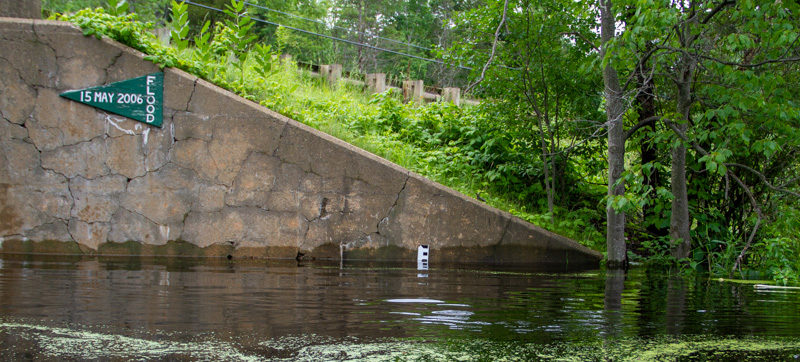This summer brought heavy rains that raised the river, as shown here at the Route 114 crossing. Now a flood of restoration funding might be heading towards our region.
A potential bright spot on the horizon is a wave of state, federal, and private foundation funding that is about to descend upon our region. With the nation’s current increased focus on climate adaptation, the Commonwealth’s relatively flush state budget, federal pandemic relief and recovery funds, and infrastructure funding could mean that more support for our work is imminent. In fact, one federal partner we spoke with this week said that the next few years might be “an unprecedented opportunity to advance green infrastructure projects.”
Green infrastructure and low impact development (LID) are water and land management approaches that restore, protect, and mimic the natural environment as much as possible. Working with nature allows communities to protect both human-built and natural systems in more sustainable ways.
That translates to habitat restoration and improvement. “Should these funding opportunities materialize,” says Executive Director Wayne Castonguay, “we are uniquely positioned to put more shovels in the ground. We and our partners have been building the foundation to advance restoration and resiliency projects for years and stand ready to deploy these funds with our partners.”
The Parker-Ipswich-Essex Rivers Restoration Partnership (PIE-Rivers), for example, was created specifically to increase the pace of habitat restoration efforts. The Great Marsh Barriers Assessment, a comprehensive regional inventory of more than 1000 dams, culverts, and other manmade structures, resulted from that partnership and was the first of its kind. The assessment ranked barriers by urgency of removal and/or improvement, making it easier for communities to prioritize resiliency projects.
Ipswich River communities have increased their understanding of climate adaptation thanks to the state’s Municipal Vulnerability Preparedness (MVP) planning workshops. And by actively participating in every one of the region’s workshops, we have successfully incorporated all of our priorities into the MVP plan for every community in our watershed.
Simply put, we could see a jump forward in our core restoration projects. Dam removal, culvert upgrades, habitat restoration, stormwater management, and groundwater protection will be key to a resilient region. By working towards a healthy Ipswich River, we will build healthier communities better able to weather whatever the future has in store.

